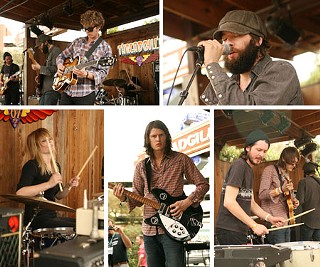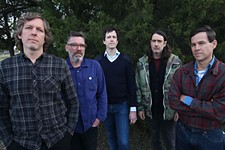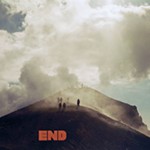I See Dead People
The Black Angels unveil 'Directions to See a Ghost'
By Austin Powell, Fri., May 9, 2008

Stephanie Bailey lives with a ghost.
"I have a wall-length mirror in my room, and these little handprints will appear on it," reveals the Black Angels drummer. "I wash it off, and it comes right back in a matter of days.
"I can't explain it, but I feel it."
Huddled outside Austin Music Rooms, a 24-hour practice studio off South First, the local psych revivalists pass fire and exchange ghost stories, an eerie, backwoods ambience settling in over the evening. The bloodshot eyes of guitarist Christian Bland widen as he recalls the gray outline of a Civil War soldier drifting among the trees at the Chickamauga battlefield in Georgia, Tenn. A similar apparition supposedly haunts the grandmother of vocalist Alex Maas on her ranch outside Lampasas, Texas, and multi-instrumentalist Kyle Hunt recounts being awakened on tour by the sensation of small hands pressing against his chest as he rested alone.
"I think there are spirits within people, different archetypes that we can recognize and identify with," Maas posits.
"Paranormal stuff definitely wouldn't surprise me," agrees guitarist/bassist Nate Ryan. "I haven't experienced much, but I'm open to it. All of these rooms used to be part of an old-folks home. Countless people have probably died in our practice space. Sometimes I like to think about that late at night and try to conjure up something in there. All of those weird experiences filter into the music."
The Black Angels' interest in unknown pleasures and collective obsession with the past should come as no surprise after 2006's Passover. The local quintet's debut LP descended like an extension of the 13th Floor Elevators' landmark Easter Everywhere, a vicious acid flashback through the darker recesses of rock & roll: Velvet Underground's confrontational drone, Love's harrowing psychedelia, and the distorted nihilism of Joy Division. Tommy Hall was one of the first to pick up on the connection.
"It is possible for Man to alter his mental state and thus alter his point of view (that is, his own basic relation with the outside world which determines how he stores his information)," wrote the 13th Floor Elevators operator on www.theblackangels.com. "It is this quest for pure sanity that forms the basis of the Black Angels."
The title of the group's sophomore album for Seattle's Light in the Attic Records, Directions to See a Ghost, refers to an old illusionary trick known as Yorick's skull, wherein after staring at an "X" placed in the eye socket of a one-dimensional skull, a photo negative of the image can be transposed onto a blank surface.
"It's about expanding your consciousness, viewing life in an alternate way," Bland instructs. "It's directions to see something in this world that supposedly doesn't exist."
Beginning to See the Light
Inside the Black Angels' practice space, the lights are all turned off save for a floor lamp tucked into a corner. Old concert posters line two of the walls, providing a slide show of the band's history, including dates with the Black Keys, Blue Cheer, and a 2007 tour promoting Scott Conn's documentary, Dirt Road to Psychedelia: Austin, Texas During the 1960s.
A smoldering haze locks in the almost tangible feel of history that permeates the room, summoning the same sensation one gets from listening to old Stax records – a combination of humidity and desperation. There's no space to maneuver, no escape from the sound.
Ryan commences the séance with the intro to "The Yellow Elevator, Part 1," unfurling an impossibly loud and reverb-drenched rockabilly riff that beckons accompaniment. The movement gradually begins to levitate until Maas enters into the fold with a heavy dose of textured organ, sending the jam into interstellar overdrive. The comedown isn't quite as pleasant.
"I don't know what it is," Bland interjects from behind a standing drum kit, "but it doesn't feel natural to stop there. It might feel better if we stop a little sooner."
As the evening progresses, the band continues to iron out new material, communicating ideas in terms of vibes and feelings. Everyone's seeking the same high.
"We try to create music that's mesmerizing in its effortlessness," Ryan says.
"If something's not working immediately, we'll try to hash it out for a bit," Maas elaborates, "but if it becomes irritating, we just move on. We have so many other songs in the vault that we can work on instead."
The five band members sample another work in progress, "The Haunting at 1300," which slows a bare-bones, Bo Diddley backbeat into one throbbing pulse. Subtlety shifting direction, Bailey straps on the bass, while Ryan slips behind the drums for "Surf City Revisted," a peyote-laced mirage of Dick Dale's "Shake 'n' Stomp" that closes with a tidal wave from Bland's guitar.
"You don't need psychedelic drugs to make or enjoy psychedelic music," Maas stresses. "They may be correlated, but it's not necessary."
Bland takes the claim one step further.
"We take you there with the music."
The Haunting at 1300
"Slip inside the eye of the mind," offers Maas, politely presenting a pipe on the back porch of the two-story, seven-bedroom bunker in South Austin that – with the exception of Hunt – houses all the Angels, including former drone machinist Jennifer Raines, who left the group earlier this year. "It can only enhance the colors."
The drone disciples are busy preparing for their first headlining tour of Europe. Bland and projectionist Adam Demitri screen-print T-shirts on the porch to commemorate the occasion; Hunt and Ryan debate over what gear to bring in from the garage, which doubles as Bland's room and could pass for the basement on That '70s Show. A lava lamp bubbles beside a rack of records and dingy couch, surrounded by an arsenal of vintage amps and equipment, all of which predate Apollo 11.
The library reads exactly the way one would expect it to, with titles ranging from Acid Trips and Chemistry and The College Drug Scene to the 13th Floor Elevators tome Eye Mind and A Sniper in the Tower: The Charles Whitman Murders. One half of the back wall is laced with a white curtain for late-night film screenings. Resting beside the archaic projection system are stacks of old tape reels, some carefully cataloged (Schizophrenia: The Shattered Mirror, parts 1 and 2; World War I; Our Wonderful Body: Medicines, Drugs, and Poisons), others hand-labeled (Ho Chi Minh, Gumby, Pete Ennis Doesn't Smoke).
"The videos work into the vibe that we're trying to project onto the crowd," explains Bland, who has a degree in advertising and a master's in graphic design. "You feed off of whatever is being shown. It's about bringing a reaction."
Since Bland and Maas, both natives of Seabrook, Texas, birthed the Black Angels in Austin, 2004, as a tribute to the Velvet Underground for an impromptu gig at Trophy's, the band has triggered a relatively complex reaction. A three-part series of self-released EPs caught the attention of Light in the Attic, which issued the band's eponymous four-song debut in 2006. Recorded that June at Cacophony Recorders, where Hunt worked as an assistant engineer before joining the group, Passover introduced Ryan into the mix and garnered significant critical acclaim. By November, the band had solidified and was living together in East Austin, slowly gaining national prominence through tours with Black Rebel Motorcycle Club and appearances at Bonnaroo and the Austin City Limits Music Festival.
In a movement that's mirrored the resurrection of visionary Elevators' singer and local icon Roky Erickson, the Angels have breathed new life into Texas psych, as evidenced by the Austin Psych Fest No. 1. Held at the Red Barn on Burnet Road in March, the daylong happening, organized and headlined by the Angels, elicited the high baptismal glow of the bygone Vulcan Gas Company, with local artists as diverse as Ringo Deathstarr and the Black tuning in and turning on for the occasion. More telling was the Jungian consciousness of the audience, a merger of cosmic cowboys and deadheads not seen since the Armadillo World Headquarters.

"We're all like-minded people, and there's a whole community of people like us," Ryan enthuses. "Nowadays everybody wants to be on their own trip, but we're not afraid to turn people on to records. That's one of the cool things that happened in the Sixties. All of these artists were openly influenced by each other. We're fortunate enough to know a lot of talented people, and we can build something that's bigger than this band."
The Black Angels recently inked a deal for future releases with Suretone, an imprint of Interscope, whose roster includes the Cure and Pink Spiders, as a means of expanding its vision globally. "If we need to go out into the desert and get out of our minds to record our next record, they've basically given us their blessing to do so," Maas enthuses. "We'll see if it comes to that."
Gimme Some Truth
The amorphous core of the Black Angels is informed by the politics of fear, the way in which everyday existence is shaped by our anxieties of the unknown. Like the biblical account referenced in the title of the band's debut, Passover coats its vision of wrath and destruction in blood, drawing parallels between "The First Vietnamese War" and the current war on terror. "Young Men Dead" was even used in a trailer for the documentary At War earlier this year.
Similar themes echo throughout Directions to See a Ghost, from the Desert Storm death rattle of "Vikings" to the ominous foreshadowing of darker days in "The Return." "You say the Beatles stopped the war," Maas intones through the Orwellian paranoia of "Never/Ever." "They might've helped find a cure, but it's still not over."
"We're still living in the Cold War, facing the possibility of nuclear extinction; there's an ongoing arm's race even if you choose not to acknowledge it," Maas clarifies. "A lot of people think that we're on the cusp of a revolution. It's not a new idea at all. If it's going to happen, it's going to take synergy. The tension builds up from adverse situations, and out of that comes the creativity and change."
That's part of the reason why Bland, Maas, and Ryan formed the Viet Minh, an improvisational side project that levitates toward the stream-of-consciousness soundtracks scored by Pink Floyd and Can. "It's a way of veering into the unknown and examining some of those fears," Ryan nods. "That's the beauty of it, and I need that."
The John Lennon hoot night at Ruta Maya proves an ample opportunity for the Viet Minh's reappropriation of the past. Screening counter to the stage, Gimme Some Truth: The Making of John Lennon's Imagine Album prefaces the performance, reiterating the political déjà vu inherent in the Angels.
The trio opens with "Tomorrow Never Knows," reducing the kaleidoscopic psychedelia of the original into a narcotic drum 'n' bass pattern over which Maas spreads a thick organ drone. Meandering into a realm of silver apples and tangerine dreams, the Viet Minh all but abandon the structure of the song, following instead its mood and message.
Turn off your mind, relax, and float down stream.
It is not dying. It is not dying.
Lay down all thought; surrender to the void.
It is shining. It is shining.
That you may see the meaning of within.
It is being. It is being.
Maas thinks of the Viet Minh as a think tank for future Black Angels material. As the three drift through "Rain" and "I Am the Walrus," it becomes apparent that the group doesn't jam so much as dig foxholes, fostering vacuums of space to filter out the surrounding chaos.
Just when the trip appears to have ended, the Tunnels join the band onstage for a rendition of "Give Peace a Chance," a chorus of disembodied voices protesting together in hallucinatory harmony: "All we are saying is give peace a chance."
Shine On
Experienced in its entirety, the physical effect of Directions to See a Ghost mirrors the illusion of Yorick's skull. In contrast to its predecessor, the new album takes longer to seep in: The moods are heavier, the movements more expansive, and the grooves thick enough to walk on. Once its full weight has sunk in, you can't escape its haunting.
Helmed again at Cacophony Recorders starting May 2006, the recording process began just one month after the release of Passover. The sessions didn't wrap up until December of last year.
"This album had more time to develop and marinate," Bland relates. "There was a lot more collaboration and jamming involved. The songs evolved as we worked them into the live sets."
Ghost represents the accumulation of the Black Angels' journey thus far, the classic reverberations of "Doves" dating back to the band's initial string of self-released EPs. The Eastern, sitar-enhanced, exploratory exposition "Deer-Ree-Shee" ventures into the realm of spirit-possession ceremonies, while the trephining dual guitars in "You on the Run" and "Science Killer" drill straight into the mind's third eye.
From Ryan's spiraling "Astronomy Domine" guitar lines and Bland's incensing jug inflections to the song's chaotic "A Day in the Life" structuring, "Never/Ever" encapsulates the spirit of the original Summer of Love, then paints it black. Rendering the song live in the band's practice space in preparation for a record store performance in Denton, Bland begins on a 12-string electric guitar, erecting a pacifying musical pattern that morphs into a veil of distortion. He leans the instrument against his amp and bolts behind the drum kit, doubling Hunt's tribal thunder. The shapes start to wander as pixilated organ circles around Ryan's guitar, floating into the horizon like a stringless kite and marking the Angels' peak ascension to date.
The concluding, 16-minute opus, "Snake in the Grass," completes the time continuum, unfolding a hypnotic underworld of somnolent soundscapes and sonic-boom guitar fissures. Somewhere in the midst of the backward effects and bad vibrations, Maas defines the Angels' ideological doctrine.
"We encourage you to rethink your preconceived notions, question authority, and create other methods for survival."
The words are disfigured beyond comprehensibility, but the directions are understood, nonetheless. The ghosts are real.
The Black Angels expel Directions to See a Ghost
Christian Bland's Top 5 Texas Psych Bands
13th Floor Elevators
The Golden Dawn
The Red Krayola
The Moving Sidewalks
Bubble Puppy








